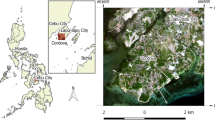Abstract
The plethora of remotely sensed datasets, specifically the Sentinel-2 data, provides an opportunity for assessment of waterlogging areas. Surface waterlogging is one of the main hazards in north Bihar, specifically in Gandak and Kosi command areas, which necessitates to map and monitor the waterlogging situation accurately at a fine scale. Present study is carried out with an objective of mapping the permanent and seasonal waterlogging areas in a flood-prone Vaishali district, Bihar state using Sentinel-2 multi-spectral data available at 10 m spatial resolution for 2020. The permanent and seasonal waterlogged area mapping were carried out using two approaches, namely spectral index (NDWI) and Otsu method based on the wetness of KT transformed images. The result suggests that both techniques could identify similar spatial patterns of waterlogged areas, while differed on area statistics. The total area under permanent and seasonal waterlogging using NDWI was less compared to the Otsu-KT approach. The higher estimate of Otsu-KT approach could be related to saturated areas, where pixels with higher moisture content during the binary thresholding approach may get classified. Although Otsu algorithm proved to be effective for delineation of water bodies and river network, its efficacy for delineation of waterlogged areas with saturated areas needs to be studied extensively.
Access this chapter
Tax calculation will be finalised at checkout
Purchases are for personal use only
Similar content being viewed by others
References
Brahmabhatt VS, Dalwadi GB, Chhabra SB, Ray SS, Dadhwal VK (2000) Land use/land cover change mapping in Mahi canal command area, Gujarat, using multi-temporal satellite data. J Indian Soc Rem Sens 28(4):221–232
Chatterjee C, Kumar R, Mani P (2003) Delineation of surface waterlogged areas in parts of Bihar using IRS-1C LISS-III data. J Indian Soc Rem Sens 31(1):57–65
Chowdhury SR, Nayak AK, Brahmanand PS, Mohanty RK, Chakraborty S, Kumar A, Ambast SK (2018) Delineation of waterlogged areas using spatial techniques for suitable crop management in Eastern India. ICAR Res Bull 79
Chowdary VM, Chandran RV, Neeti N, Bothale RV, Srivastava YK, Ingle P, Singh R et al (2008) Assessment of surface and sub-surface waterlogged areas in irrigation command areas of Bihar state using remote sensing and GIS. Agricult Water Manag 95(7):754–766
Du Y, Zhang Y, Ling F, Wang Q, Li W, Li X (2016) Water bodies’ mapping from Sentinel-2 imagery with modified normalized difference water index at 10-m spatial resolution produced by sharpening the SWIR band. Rem Sens 8(4):354. https://doi.org/10.3390/rs8040354
Dutta D, Sharma JR, Bothale RV, Bothale V (2004) Assessment of waterlogging and salt affected soils in the command areas of all major and medium irrigation project in India. Technical document. Regional Remote Sensing Service Centre, Jodhpur, India, 1–74
Fattore C, Abate N, Faridani F, Masini N, Lasaponara R (2021) Google earth engine as multi-sensor open-source tool for supporting the preservation of archaeological areas: the case study of flood and fire mapping in Metaponto, Italy. Sensors 21:1791
Fisher A, Flood N, Danaher T (2016) Comparing landsat water index methods for automated water classification in eastern Australia. Rem Sens Environ 175:167–182. https://doi.org/10.1016/j.rse.2015.12.055
Gorelick N, Hancher M, Dixon M, Ilyushchenko S, Thau D, Moore R (2017) Google Earth Engine: planetary-scale geospatial analysis for everyone. Rem Sens Environ 202:18–27
Han-Qiu X (2005) A study on information extraction of water body with the modified normalized difference water index (MNDWI). J Rem Sens 5:589–595
Jingqi Z, Wei G, Ping S (2011) Automatic water bodies extraction model based on KT transformation. Sci Soil Wat Conserv 3:88–92
Li J, Peng B, Wei Y, Ye H (2021) Accurate extraction of surface water in complex environment based on Google Earth Engine and Sentinel-2. Plos One 16(6):e0253209
Lohani AK, Jaiswal RK, Jha R (1999) Waterlogged area mapping of Mokama group of Tals using remote sensing and GIS. J Inst Eng 80:133–137
McFeeters SK (1996) The use of the normalized difference water index (NDWI) in the delineation of open water features. Int J Remote Sens 17(7):1425–1432. https://doi.org/10.1080/01431169608948714
Nedkov R (2017) Orthogonal transformation of segmented images from the satellite Sentinel-2. Comptes Rendus De L’academie Bulgare Des Sciences 70(5):687–692
Otsu N (1979) A threshold selection method from gray-level histograms. IEEE Trans Syst Man Cybern 9(1):62–66
Shi T, Xu H (2019) Derivation of tasseled cap transformation coefficients for Sentinel-2 MSI at-sensor reflectance data. IEEE J Sel Top Appl Earth Observ Rem Sens 12(10):4038–4048. https://doi.org/10.1109/JSTARS.2019.2938388
Wang J, Ding J, Yu D, Ma X, Zhang Z, Ge X, Teng D, Li X, Liang J, Lizaga I et al (2019) Capability of Sentinel-2 MSI data for monitoring and mapping of soil salinity in dry and wet seasons in the Ebinur Lake region, Xinjiang, China. Geoderma 353:172–187
Xie H, Luo X, Xu X, Pan H, Tong X (2016) Evaluation of Landsat 8 OLI imagery for unsupervised inland water extraction. Int J Remote Sens 37(8):1826–1844. https://doi.org/10.1080/01431161.2016.1168948
Xu L, Ma A (2021) Coarse-to-fine waterlogging probability assessment based on remote sensing image and social media data. Geospat Inf Sci 24(2):279–301
Yang X, Chen L (2017) Evaluation of automated urban surface water extraction from Sentinel-2A imagery using different water indices. J Appl Remote Sens 11(2):026016. https://doi.org/10.1117/1.JRS.11.026016
Zhou S, Kan P, Silbergagel J, Jin J (2020) Application of image segmentation in surface water extraction of fresh water lakes using Radar data. Int. J. Geo-Inf. 9(424):1–16. https://doi.org/10.3390/ijgi9070424
Author information
Authors and Affiliations
Corresponding author
Editor information
Editors and Affiliations
Rights and permissions
Copyright information
© 2022 The Author(s), under exclusive license to Springer Nature Switzerland AG
About this chapter
Cite this chapter
Neeti, N., Pandey, A., Chowdary, V.M. (2022). Delineation of Waterlogged Areas Using Geospatial Technologies and Google Earth Engine Cloud Platform. In: Pandey, A., Chowdary, V.M., Behera, M.D., Singh, V.P. (eds) Geospatial Technologies for Land and Water Resources Management. Water Science and Technology Library, vol 103. Springer, Cham. https://doi.org/10.1007/978-3-030-90479-1_8
Download citation
DOI: https://doi.org/10.1007/978-3-030-90479-1_8
Published:
Publisher Name: Springer, Cham
Print ISBN: 978-3-030-90478-4
Online ISBN: 978-3-030-90479-1
eBook Packages: Earth and Environmental ScienceEarth and Environmental Science (R0)




